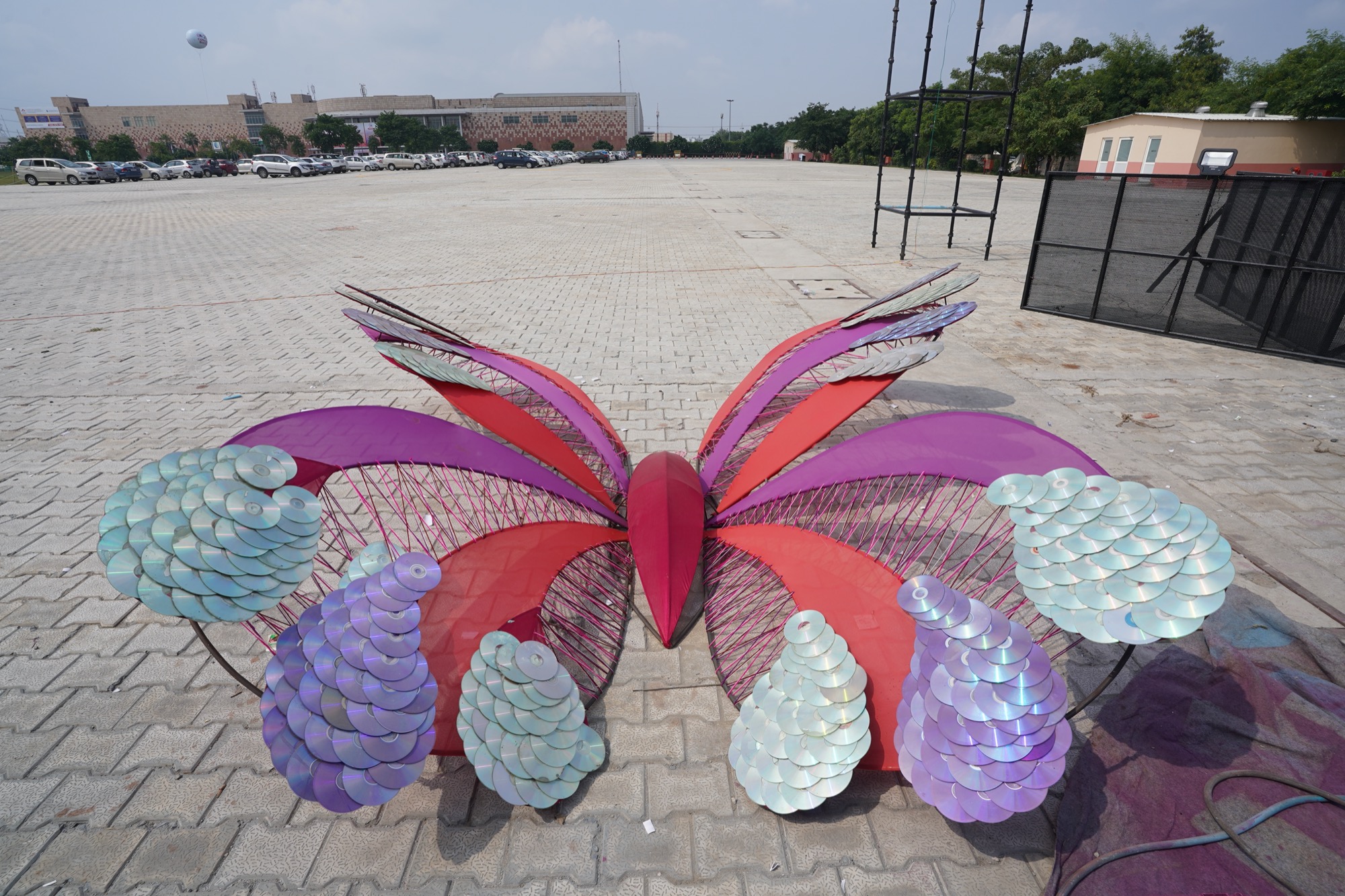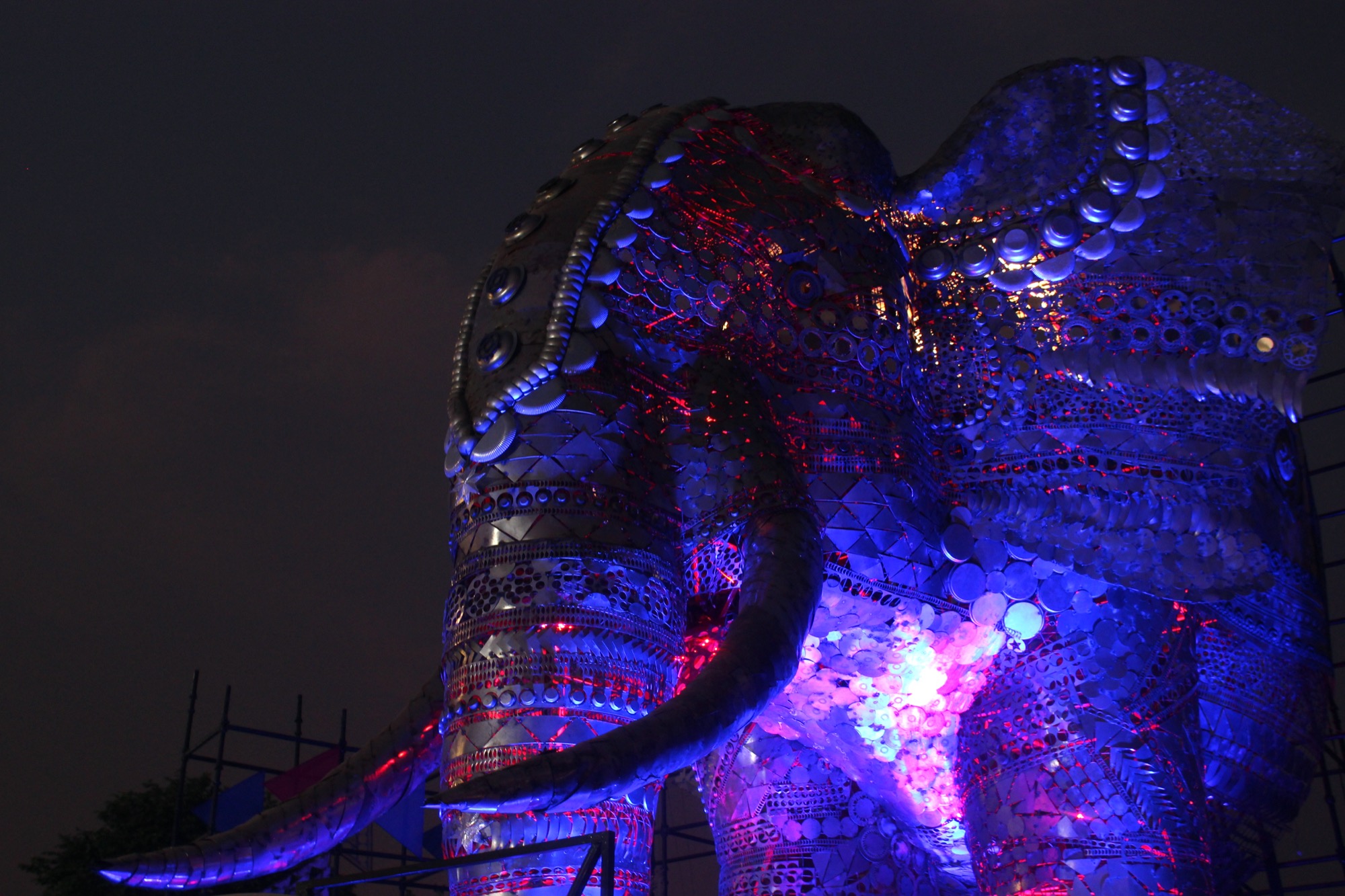Every year for the last 25 years Export Promotion Council for Handicrafts has been organising Indian Handicrafts and Gift Fair Exhibition. The fair happening in the month of October and is called Autumn Fair and the one happening in February is called Spring Fair. This is amongst Asia’s largest gifts & handicrafts fair. The design of the fair has always been one of pinnacle point of the event and for the last 3 years, the firm TOD Innovations Pvt Ltd has done the design. The theme has varied from Banyan Tree to Colours of India (2018 Autumn). This year both the organiser and the architect wanted a theme that is relevant, relatable to the global audience, and significant enough to the context in which it is set. This gave rise to the idea ReUse, Recycle & Reduce
The designers then began brainstorming with their team, which consisted of Architects, Product Designers, Artists, Lighting Designers, Exhibition Designers, and Graphic Designers. This has always been the central idea of Ar. Kulveer Bhati & Ar.Ritu Yadav, the directors of the firm TOD Innovation to collaborate and have a multi-disciplinary approach to solve any design problem. Probably that is the reason that won the state of Bihar its first Gold Medal at Pavilion Design at India International Trade Fair in the year 2014. Coming back to the problem at hand, the idea evolved to inform the public about “The Environment” through Reuse, Recycle and Reduce.
They divided the environment into elements of earth, fire, water & air (Prithvi, Jal, Vayu & Akash) and designed installations for the fair around it. The awareness came from two-folds on one hand’s animals were used directly to represent the element on second the entire installations were made of waste. In total the whole exhibition had used the following waste/scrap or used materials for the installation:
Reliance Conduits: 800kg
Denim Fabric: 1200kg
CD: 15000 nos
MotherBoard : 1000kg
PVC pipes: 2000 Kg
Bottle Cap: 8000 nos
Plastic Bottle: 3000 nos
Carpet Waste: 250 meters
The animal usage although was meant to draw attention to the state of the environment, it drew people close to the installation and made it truly immersive art. The selection process of animals was also a tedious process; a lot was dependent on it. Which species of the animal kingdom best represent its element, state of the environment and can be represented through otherwise waste materials. After a long debate, Butterfly in context of mountains was chosen to represent air in façade of the fair, Whale in context of the ocean for water was decided for the registration area (main entrance) and elephant for land at the buyers lounge or exit area. The studio Black Bird Design from Mumbai were entrusted with converting these ideas to sculpture.
 The butterfly was chosen as its one of the most delicate beings, its often used as an indicator of a healthy environment. The immense 110-meter by 18-meter building façade has been encrusted with the mountains symbolized through jagged peaks, while the foreground has large scale butterflies. The installation is made from waste materials and industrial by-products and is supported on reusable scaffoldings. The mountains are layered using motherboards, metal scraps, LED panels, PVC pipes and lycra fabric; while the butterflies are adorned with plastic bottles and lids, electric wires and garden pipes. The lighting for façade always played a critical role, as it sees most traffic through out the day. The lighting designer Thiruvengadam R B of URI Design Studio devised layering as a prime method for lighting up the façade. The background was uplight and butterflies were picked individually from far.
The butterfly was chosen as its one of the most delicate beings, its often used as an indicator of a healthy environment. The immense 110-meter by 18-meter building façade has been encrusted with the mountains symbolized through jagged peaks, while the foreground has large scale butterflies. The installation is made from waste materials and industrial by-products and is supported on reusable scaffoldings. The mountains are layered using motherboards, metal scraps, LED panels, PVC pipes and lycra fabric; while the butterflies are adorned with plastic bottles and lids, electric wires and garden pipes. The lighting for façade always played a critical role, as it sees most traffic through out the day. The lighting designer Thiruvengadam R B of URI Design Studio devised layering as a prime method for lighting up the façade. The background was uplight and butterflies were picked individually from far.
The whale was chosen, as it’s the most common victim of water pollution with plastic, as per WWF globally 1,00,000 marine animals die every year due to plastic pollution This includes whales, dolphins, porpoises, seals and sea lions (https://www.wwf.org.au/news/blogs/plastic-in-our-oceans-is-killing-marine-mammals#gs.dtti2g). This enormous 65 feet long Whale has been suspended from above. It has been constructed by an artist with denim, PVC conduits (used by Reliance), carpets, metal scraps, mosquito net, lycra fabric and basketball. The ocean on the other hand has been made out of carpet waste generated in exhibitions. The registration background was completely out metal scrape from Moradabad fixed in MS frame. Lighting played a major role here, as this area has the little intrusion of daylight. The lighting designer engineered a solution of creating the ocean effect within the space while ensuring the process of registration is not hampered. Projection mapping on the whale was primarily to educate the viewer, space truly and literally became immersive inexperience.
The elephant was chosen not only for his role as an auspicious entity in Indian culture but also because of its largest land based mammal and we are losing almost 100 elephants a day to poaching alone (https://worldelephantday.org/about/elephants). The reason it’s a grave concern in because of a recent paper published in The Royal Society of Publishing that apart from humans, elephants have the largest ability to influence their natural environments. The paper goes on to establish that the extinction of elephants can lead to extinction of tropical tree forest due to lack of effective seed dispersal. This gigantic awe-inspiring 32ft high installation of the elephant weighs a staggering 5-ton! This masterpiece exemplifies the artistic dexterity, creativity and imagination in creating intricate patterns out of metal scraps. Sculptors from Orissa were paired with designers from NID to create this masterpiece, which became the showstopper of the fair. The entire sculpture is designed to be dismountable. The lighting of this magnificent piece of art was tricky as we had created a totally different experience at night without compromising on the grandness of the installation. Hence the lighting designer came up with the idea of contrasting light between inside and outside with colour and intensity and create the depth in the installation. This feature made it a prominent selfie point at night.
While going back and one looks at the installation at the entrance of gate no.1, which always gets missed during the day, as no one pauses at the entrance in the morning. This 32-foot-tall eye-catching installation symbolically represents Agni (fire) and Vayu (air), two of the five great elements of cosmic creation or Pancha Maha-Bhoota according to the Hindu philosophy. The power of nature – Fire and Air – is represented through colourful triangles. Nature thrives when these two elements are in a state of balance, but the repercussions could potentially be devastating when the balance tilts. Hence, the irony of messaging lies in the articles used, all reminiscent of excessive human material consumption contributing to the accumulation of human-generated waste, a big contributor to climate change. The installation is made from waste materials and industry byproducts like plastic caps and bottles, glass bangles, spray cans, garden pipes, PVC pipes, CDs and lycra fabric.
The exhibition industry has always had ephemeral nature, and everything comes back to normalcy after the fair is over. However, here the memory created was intended to have a lasting effect. Breathing currently in the pollution-infested city, one does wonder on way ahead, and it is in that juncture we think about the IHGF 2019 Autumn fair and the message it carried. The amount of waste used or recycled in this exhibition might be enormous, but comparing to the amount of waste being generated by us humans every single day, we need a lot many exhibitions to reduce the impact of these waste on our mother earth, hence its time to Reimagine the Exhibitions.
Location: Expo Mart, Greater Noida
Architect: TOD Innovations Pvt ltd
Exhibitor: Deepali Design
Artist: Black Bird Design
Lighting Design: URI Design Studio
Graphic Design: TOD Innovations Pvt ltd
Videography: Abhineet Dang
Photography: Rohan Dayal, Abhineet Dang & Shreedevi VK
































